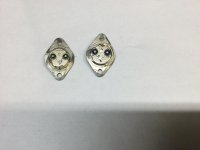I have written up about the stability of EF stage in general, not limited to EF3.stabilizing EF3
Here is how to tame the EF3: https://www.diyaudio.com/community/...tor-with-emitter-follower.421436/post-7881316
To get insight of what is happening, please go to the OP of that thread.
Hi BesPav,
Absolutely! Read previous material and then open a thread to further the discussion.
To keep the noise level down, try to confine your discussion without comparison to other types of configurations. Everyone has their favorite and you don't need that argument!
Absolutely! Read previous material and then open a thread to further the discussion.
To keep the noise level down, try to confine your discussion without comparison to other types of configurations. Everyone has their favorite and you don't need that argument!
I simulated putting current feedback around each output transistor. This is what CFP and audio-frequency bias regulators do.
The current feedback makes the BJT's exponential appear steeper. The optimum bias voltage is 26mV divided by the loop gain. One can use the loop gain to reduce the bias current, the emitter resistors, or some combination. For lowest distortion, one reduces the emitter resistors, but the smaller voltage negates the improvement in bias stability.
The THD wars have been driving smaller emitter resistors, higher bias currents, and more accurate thermal tracking. If one is not trying to win the THD wars, one can back off on all of these.
Ed
The current feedback makes the BJT's exponential appear steeper. The optimum bias voltage is 26mV divided by the loop gain. One can use the loop gain to reduce the bias current, the emitter resistors, or some combination. For lowest distortion, one reduces the emitter resistors, but the smaller voltage negates the improvement in bias stability.
The THD wars have been driving smaller emitter resistors, higher bias currents, and more accurate thermal tracking. If one is not trying to win the THD wars, one can back off on all of these.
Ed
That's something I've been doing since the 1980's. Getting matched sets of same polarity transistors was very expensive back then. You pretty much had to buy full rails to get good matches. You did your best NPN to PNP. They won't track anyway, but closer is better than not.
We are so lucky these days!!
We are so lucky these days!!
That's cool. I used old MJ15003/4s which were probably not well matched. The EF3 should bury the output transistor's mismatch in the pre-driver and driver bias currents, but I can't tell for sure.
Ed
Ed
Hi Ed,
I used the same parts, plus MJ15024 and MJ15025. I had to limit skews. Also used 2SD424 / 2SB554 and 2SD555 / 2SB600. 2N6031 and 2N5631 were another good pair. For the time, these were all excellent parts.
If I ever saw MJ15015 and MJ15016 ... they went into the garbage. Even Motorola classified them as "economy transistors" (code for complete garbage, non-critical applications only!).
I used the same parts, plus MJ15024 and MJ15025. I had to limit skews. Also used 2SD424 / 2SB554 and 2SD555 / 2SB600. 2N6031 and 2N5631 were another good pair. For the time, these were all excellent parts.
If I ever saw MJ15015 and MJ15016 ... they went into the garbage. Even Motorola classified them as "economy transistors" (code for complete garbage, non-critical applications only!).
If I ever saw MJ15015 and MJ15016 ... they went into the garbage. Even Motorola classified them as "economy transistors" (code for complete garbage, non-critical applications only!).
They grew out of the 2N3055/MJ2955. “What did you expect? What did you reasonably expect??” Certainly not MORE gain, considering that hFE varies inversely as Vceo within a given lot. I’ve had some actual Motorola 2N3055s that zenered north of 200V. Gain of maybe 25 at an amp. Gonna be hell on your drivers if you run 4 ohm loads. Last batch of MJ15016 I had ran around hFE of 7 at 7 amps. That’s an amp of base current. Even your favorite sustained beta drivers are going to be falling off up that high. Not to mention getting hot.
MJ15003/4 grew out of the 2N5631/6031.
Another huge issue was the beta difference between the MJ15015 and MJ15016. I didn't know they came from the 2N3055 process, but it figures. I didn't pay much attention to them. To my mind, 2N3055 is a linear power supply pass transistor. That's it.
The 2N5631 - MJ15003 and compliments are no surprise I guess, they were all very good transistors.
The 2N5631 - MJ15003 and compliments are no surprise I guess, they were all very good transistors.
lol!
Not surprised one bit!
I didn't stock any of those economy parts. So they never saw any designs or service work. I know very little about them except to avoid them. The 2N3055 saw service in power supplies, usually a bunch in parallel.
Not surprised one bit!
I didn't stock any of those economy parts. So they never saw any designs or service work. I know very little about them except to avoid them. The 2N3055 saw service in power supplies, usually a bunch in parallel.
Hi, jxdking!I have written up about the stability of EF stage in general, not limited to EF3.
Yes, EF general and EF3 can be described in terms of impedance conversion.
Your approach are good and really allow to stabilize EF3, but provides relatively slow OPS (not too wideband).
I will try to integrate all the ways with comprehensive description in one complicated message.
And of course I will try to describe very wideband EF3 OPS, not shown (or I have not seen) anywhere at DIYAudio.
Stay tuned.
Hi, Anatech!Absolutely! Read previous material and then open a thread to further the discussion.
Agreed, thank you.
- Home
- Amplifiers
- Solid State
- Optimal bias in push-pull EF output stage: textbooks and reality
